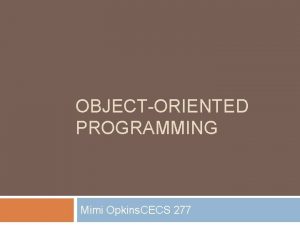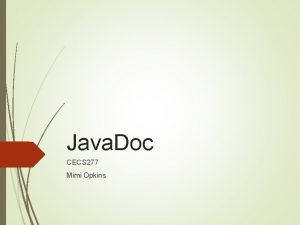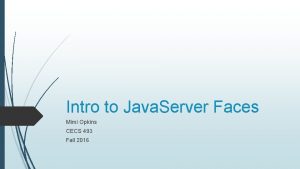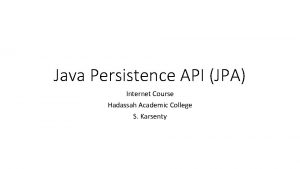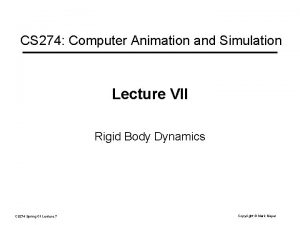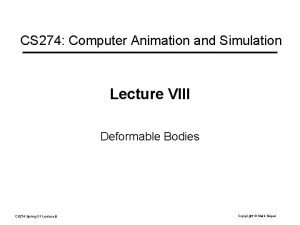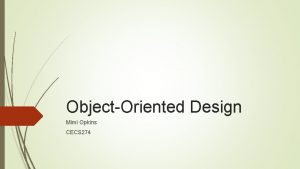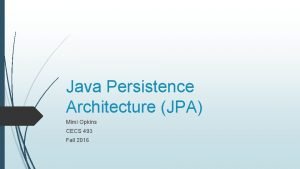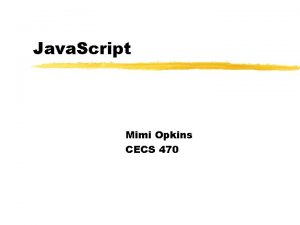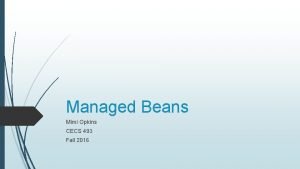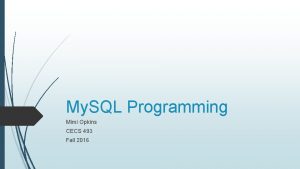Writing Java Docs Mimi Opkins CECS 274 Copyright













- Slides: 13

Writing Java. Docs Mimi Opkins CECS 274 Copyright (c) Pearson 2013. All rights reserved.

Javadoc comments /** * description of class/method/field/etc. * * @tag attributes *. . . * @tag attributes */ • Javadoc comments: Special comment syntax for describing detailed specifications of Java classes and methods. – Put on class headers, methods, constructors, public fields, . . . • Benefit: Tools can turn Javadoc comments into HTML spec pages. – Eclipse and other editors have useful built-in Javadoc support. • Main drawback: Comments can become bulky and harder to read. 2

Javadoc tags • on a method or constructor: tag @param name description @return description @throws Exception. Type reason description describes a parameter describes what value will be returned describes an exception that may be thrown (and what would cause it to be thrown) {@code sourcecode} for showing Java code in the comments {@inherit. Doc} allows a subclass method to copy Javadoc comments from the superclass version • on a class header: tag description @author name author of a class @version number class's version number, in any format 3

Javadoc example /** * Each Bank. Account object models the account information for * a single user of Fells Wargo bank. * @author James T. Kirk * @version 1. 4 (Aug 9 2008) */ public class Bank. Account { /** The standard interest rate on all accounts. */ public static final double INTEREST_RATE = 0. 03; . . . } /** * Deducts the given amount of money from this account's * balance, if possible, and returns whether the money was * deducted successfully (true if so, false if not). * If the account does not contain sufficient funds to * make this withdrawal, no funds are withdrawn. * * @param amount the amount of money to be withdrawn * @return true if amount was withdrawn, else false * @throws Illegal. Argument. Exception if amount is negative */ public boolean withdraw(double amount) {. . . } 4

Javadoc output as HTML • Java has tools to convert Javadoc comments into web pages – from Terminal: javadoc -d doc/ *. java – Eclipse has this built in: Project → Generate Javadoc. . . – The actual Java API spec web pages are generated from Sun's Javadoc comments on their own source code: 5

Javadoc HTML example • from java. util. List interface source code: /** * Returns the element at the specified position * in this list. * <p>This method is <em>not</em> guaranteed to run * in constant time. In some implementations it may * run in time proportional to the element position. * * @param index of element to return; must be * non-negative and less than size of this list * @return the element at the specified position * @throws Index. Out. Of. Bounds. Exception if the index is * out of range * ({@code index < 0 || index >= this. size()}) */ public E get(int index); – Notice that HTML tags may be embedded inside the comments. 6

Javadoc enums, constants • Each class constant or enumeration value can be commented: /** * An instrument section of a symphony orchestra. * @author John Williams */ public enum Orchestra. Section { /** Woodwinds, such as flute, clarinet, and oboe. */ WOODWIND, /** Brass instruments, such as trumpet. */ BRASS, /** Percussion instruments, such as cymbals. */ PERCUSSION, } /** Stringed instruments, such as violin and cello. */ STRING; 7

Using @param/return • Don't repeat yourself or write vacuous comments. /** Takes an index and element and adds the element there. * @param index to use * @param element to add */ public boolean add(int index, E element) {. . . • better: /** Inserts the specified element at the specified * position in this list. Shifts the element currently at * that position (if any) and any subsequent elements to * the right (adds one to their indices). Returns whether * the add was successful. * @param index at which the element is to be inserted * @param element to be inserted at the given index * @return true if added successfully; false if not * @throws Index. Out. Of. Bounds. Exception if index out of range * ({@code index < 0 || index > size()}) */ public boolean add(int index, E element) {. . . 8

Your Javadoc is your spec • Whenever you write a class to be used by clients, you should write full Javadoc comments for all of its public behavior. – This constitutes your specification to all clients for your class. – You can post the generated HTML files publicly for clients to view. – Common distribution of a library of classes: • binaries (. class files, often packaged into an archive) • specification (Javadoc. html files, or a public URL to view them) – Eclipse uses Javadoc for auto-completion. • Write Javadoc comments for all exposed API elements. (anything that is non-private) 9

Javadoc and private • Private internal methods do not need Javadoc comments: /**. . . a Javadoc comment. . . */ public void remove(int index) {. . . } // Helper does the real work of removing // the item at the given index. private void remove. Helper(int index) { for (int i = index; i < size - 1; i++) { element. Data[i] = element. Data[i + 1]; } element. Data[size - 1] = 0; size--; } – Private members do not appear in the generated HTML pages. 10

Custom Javadoc tags • Javadoc doesn't have tags for pre/post, but you can add them: tag description @pre condition (or @precondition) notes a precondition in API documentation; describes a condition that must be true for the method to perform its functionality @post condition (or @postcondition) notes a postcondition in API documentation; describes a condition that is guaranteed to be true at the end of the method's functionality, so long as all preconditions were true at the start of the method – By default, these tags won't show up in the generated HTML. But. . . 11

Applying custom tags – from Terminal: javadoc -d doc/ -tag pre: cm: "Precondition: " -tag post: cm: "Postcondition: " *. java – in Eclipse: Project → Generate Javadoc. . . → Next → in the "Extra Javadoc options" box, type: -tag pre: cm: "Precondition: " -tag post: cm: "Postcondition: " – The generated Java API web pages will now be able to display pre and post tags properly! 12

More custom Javadoc tags tag description @modifies object(s) a more specific postcondition; describes any state of this object or other object(s) that may be changed by a call to this method @effects object(s) a more specific postcondition; describes any promises this method makes about the final state in which it will leave some other object(s) when it is done running 13
